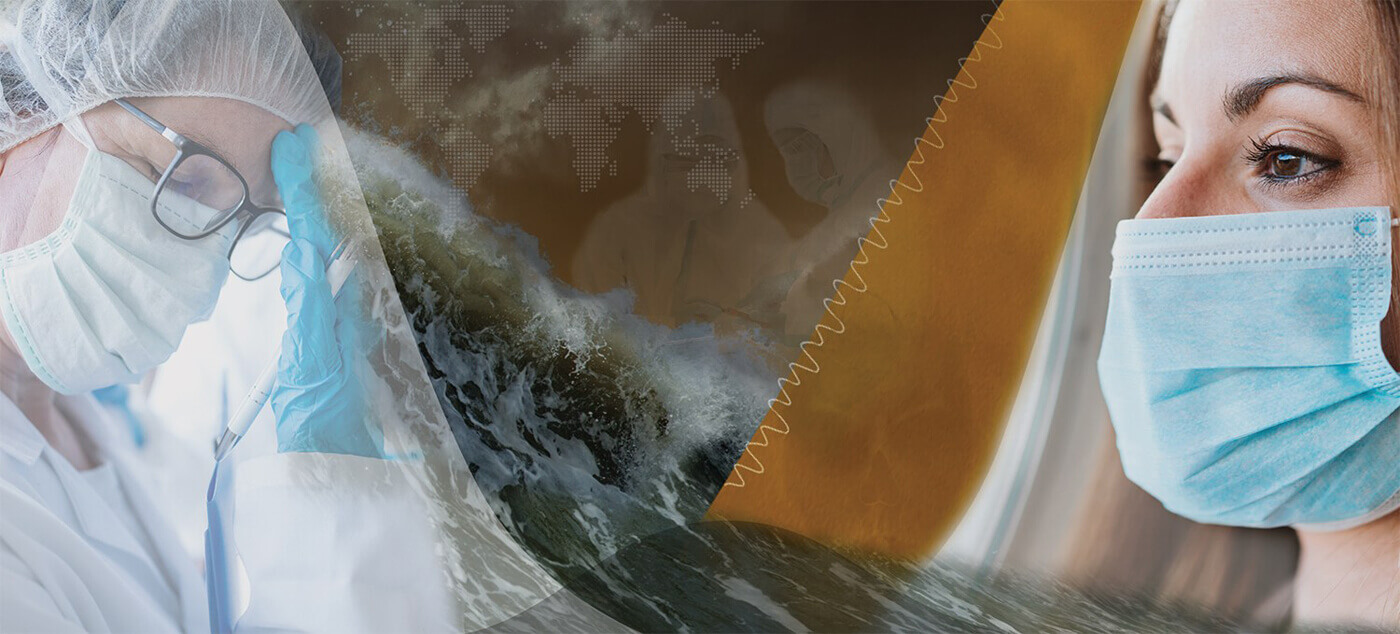To provide these insights, Verilogue has engaged in voice-enabled pulse surveys with ER Physicians, and have analyzed 63 responses collected in April 2020
As of April, two distinct stories are emerging from ER physicians on the front lines of the COVID-19 pandemic. These stories are shaped by location: those who are currently in the midst of a war-like chaos in a COVID-19 ‘hot spot’ (e.g. New York City), and those who are dealing with a sense of impending doom while preparing for a future peak.
We present these stories through the voices of the physician themselves:
PEAK OF CONCERN
ER Physicians currently managing the height of their local outbreaks are ‘drowning’ from the extreme physical and emotional burden.
“This is like being in a war zone with a constant barrage of incoming casualties. No end in sight. No idea what resources you’ll have for the next hour or day or week or month. It is overwhelming. Stressful. Causing a major burnout as well as fear for the, uh, the people on the front line for their, for their own lives. Uh, lots of people have written wills and said goodbye to their family and never expecting to see them again. It’s absolutely devastating”
Every single thing that comes in through the door in my emergency department is COVID. Um, people are de-sating in front of me faster than I can put them on oxygen. It’s, it’s, uh, it’s a mess
These physicians are driven by their duty to treat the sick, though they are fearful of their ability to protect themselves, due to a lack of available resources (esp. PPE):
“Intubating patients with Covid-19 had been the first time in many years that I’ve actually been frightened during my practice of emergency medicine”
“It has been challenging, as we do not have enough PPE for our staff. We are having to use homemade PPE and rely on friends and family to help us. We desperately need more PPE”
Despite doing their best to treat the patient physically, from an emotional support standpoint, they are at a loss. They recognize their inability to provide the patient with ‘a good death’ as families are not allowed to be with loved ones during their final moments.
“It’s very disheartening and frustrating. Um, you feel kind of helpless. Patient after patient comes in in respiratory distress. You intubate them and they code. There’s no family around and the pattern repeats. Another one comes in, gets intubated and then codes. All the while you hear code ninety nine over the head for the different floors, for other patients.”
“Patients are frustrated just as well as healthcare providers are. We are uncertain of what the future will look like. One of the hardest things has also been not allowing patients to have family members at their bedside or visit them sometimes even in times of death.”
Despite the experience of treating COVID-19 patients for several weeks, a prominent sense of uncertainty and frustration still looms among these physicians, due to lack of modern precedent and constant changes in disease understanding:
“It has been chaotic. Um, policies and protocols are changing every day. Every day we have a team meeting to go over what new protocols there are”
“This is unparalleled in my medical career. I have never seen anything like this before”
APPROACHING CONCERN:
Though physicians located outside of current COVID-19 hotspots do not currently suffer from the same physical burdens as those dealing with the height of the epidemic, they experience unique emotional burdens. Despite media reports detailing the experiences of others across the country and world, these physicians recognize the many unknowns associated with this disease, leading them to question their own level of preparedness.
“We are seeing a few COVID patients right now, but anticipate that that will rapidly expand, period. Everyone is stressed due to the sense of impending disaster and lack of resources.”
“This disease is consuming everybody’s life, and their livelihood. I have been anxious, stressed out every day, and it’s very, um, sombering because I don’t know what the future holds.”
“I don’t know if we’ll be prepared fully when it does hit, if it does”
Notwithstanding this uncertainty, they have prepared to the greatest extent possible (expanding hospital beds; sourcing supplies), taking advantage of the current low hospital census and mostly-empty ER (due to the focus on treating true medical emergencies) as much as possible.
“Our hospital census is down by half, uh, elective surgeries are cancelled. Elective procedures are cancelled. Uh, some of our staff has taken furloughs. Some of our staff is being re-purposed. So, it hasn’t hit us very hard yet. Uh, we are preparing for a large surge. So, we’re taking this time now that we have a low census to prepare our staff, um, clear out areas that, um, normally wouldn’t be, uh, inpatient beds to be used as inpatient beds. Getting all of our equipment as much as we can. Our PPE and preparing to make, um, our hospital that normally has over eight hundred beds, into twelve hundred beds. We don’t know if we’ll use all that, but we are preparing for this surge”
“For right now, um, a lot of us are sitting around honestly twiddling our thumbs… We’re all ready, we’re all waiting”
“Right now I feel like we’re like in the eye of the hurricane and we are going to have a massive surge coming”
WHAT IS NEXT?
Despite the increasing clarity around the short term disease projections, long term uncertainty prominates across both ER Physician groups. In the words of one physician currently working in a COVID-19 hotspot:
“It’s been a whirlwind, but I don’t think the chaos is done just yet”
Best of health,
Verilogue
The insights presented in this content piece were developed through a collaborative effort across Verilogue’s research team

